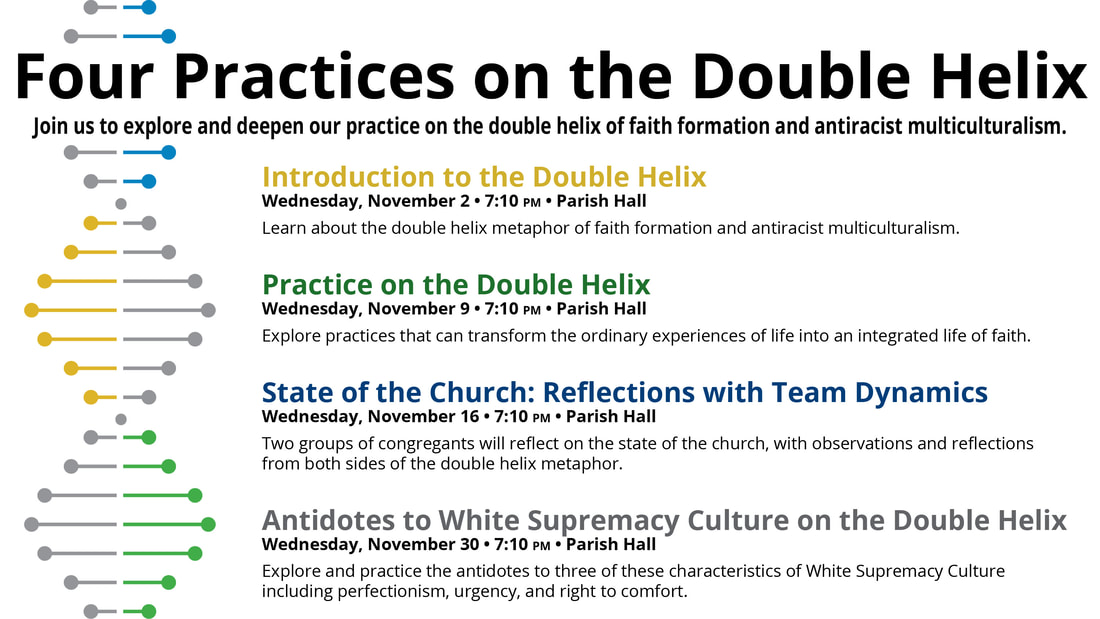|
Erika Sanders, Beloved Community Communications Team On November 2, Unity Church began a series of four Wellspring Wednesday gatherings called “Four Practices on the Double Helix.” Each session has deepened our exploration and practice of the Double Helix of Faith Formation and Antiracist Multiculturalism. The fourth and last session is November 30.
During this first of the series, Angela Wilcox and Laura Park provided an introduction to the Double Helix model and its creation. Angela described how Unity’s ministers and Beloved Community Staff team had, for many years, aimed to develop a way of offering guidance to congregants on deepening both their spiritual practices and their antiracist multiculturalism work. As a congregation long committed to building the Beloved Community, and as a community hurting and angry about the murder of George Floyd in May 2020, many of us have wished to participate in these types of activities, but have struggled to know how to start. We have asked ourselves questions like, “what is distinctive about antiracism efforts in a religious context, compared to such efforts elsewhere in our communities?” and, “why does my participation in a church community and my spiritual development feel so tied to antiracist multicultural work?” To engage with these challenging questions, Unity staff thought about describing faith formation and antiracist multiculturalism in multiple ways: for example, as a path, or as a map. Ultimately, however, the double helix metaphor surfaced as the most apt way to describe how faith formation and antiracist multiculturalism can exist in our lives: the double helix has no end point, no destination. It is a model that represents well how each half depends upon and interacts with the other. It is a model that is built upon practice. Angela and Laura led us in an exercise that demonstrated all of these elements of the double helix. Each person was given a piece of paper on which either a spiritual practice or antiracist practice was written. Examples of spiritual practices included chanting, prayer, breathwork, worship and time in nature. Antiracist practice examples included asking questions without assuming, sharing stories across difference, noticing and naming cultural differences, noticing and naming discomfort without shame, and asking, in any discussion, what impact race is having. Next, people given a spiritual practice connected with another person who had an antiracist practice on their paper, and the two individuals discussed how those two practices could relate to one another. Participants switched partners several times, giving each person the opportunity to consider and discuss multiple types of practices. In subsequent gatherings in this series, we will continue to explore the double helix model and how it can support our faith formation and antiracist multicultural work.
0 Comments
Leave a Reply. |
Topics
All
Beloved Community ResourcesUnity Justice Database
Team Dynamics House of Intersectionality Anti-Racism Resources in the Unity Libraries Collection Creative Writers of Color in Unity Libraries The History of Race Relations and Unity Church, 1850-2005 Archives
July 2024
Beloved Community Staff TeamThe Beloved Community Staff Team (BCST) strengthens and coordinates Unity’s antiracism and multicultural work, and provides opportunities for congregants and the church to grow into greater intercultural competency. We help the congregation ground itself in the understanding of antiracism and multiculturalism as a core part of faith formation. We support Unity’s efforts to expand our collective capacity to imagine and build the Beloved Community. Here, we share the stories of this journey — the struggles, the questions, and the collaborations — both at Unity and in the wider world.
The current members of the Beloved Community Staff Team include Rev. Kathleen Rolenz, Rev. KP Hong, Rev. Lara Cowtan, Drew Danielson, Laura Park, Lia Rivamonte and Angela Wilcox. |
